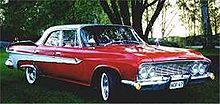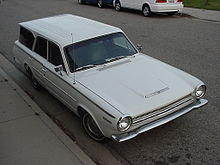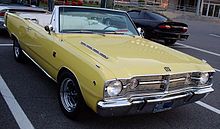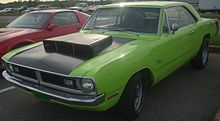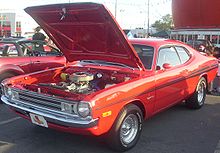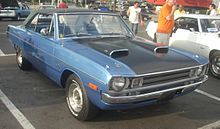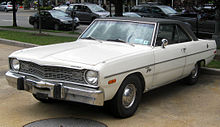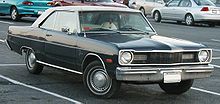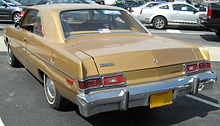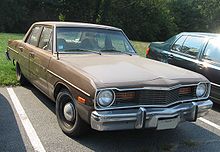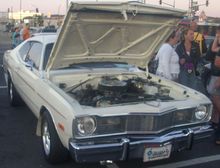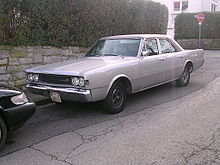- Dodge Dart
-
Dodge Dart 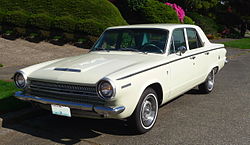
Manufacturer Chrysler Corporation Production 1960–1976 Predecessor Dodge Lancer (For compact version) Successor Dodge Aspen Class Full-size (1960–1961)
Mid-size (1962)
Compact (1963–1976)Layout FR layout Related Plymouth Valiant
Chrysler Valiant
Dodge PhoenixThe Dodge Dart is an automobile built by the Dodge division of the Chrysler Corporation from 1960-1976 in North America, with production extended to later years in various other markets. The Dart was introduced as a lower-priced, shorter wheelbase, full-size Dodge in 1960 and 1961, became a mid-size car for 1962, and finally was a compact from 1963-1976. Chrysler had previously applied the "Dart" name to a Ghia-built show car in 1956.[1][2]
The project planners proposed the name Dart, only to have executives demand an expensive research program which produced the name Zipp.[3] This was promptly rejected in favor of Dart.[4] The name found favor as the market had been recently introduced to a new military aircraft called the Convair F-106 Delta Dart, commonly known as the "Delta Dart", in a marketing attempt to appeal to the excitement surrounding the Space Race during the early 1960s.
Contents
1960
First generation 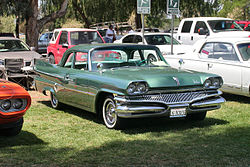
Production 1960–1961 Assembly Windsor, Ontario, Canada Body style 4-door sedan
4-door wagon
2-door sedan
2-door hardtopEngine 225 cu in (3.7 L) Slant-6
318 cu in (5.2 L) V8
361 cu in (5.9 L) V8
383 cu in (6.3 L) V8Transmission 3-speed manual
3-speed Torqueflite automaticWheelbase 118 in (2,997 mm) Length 209.4 in (5,319 mm) Width 78.7 in (1,999 mm) Height 54.8 in (1,392 mm) Related Dodge Phoenix The first Dodge Darts, introduced for the 1960 model year, were reduced-size large cars developed to replace the Plymouth as the low-priced car for the Dodge dealer network; Dodge dealers had been selling Plymouths since 1930, but divisional restructuring in 1960 took Plymouth away from the Dodge dealer network. The Dart had a shorter wheelbase than the standard-size Dodge line, and was based on the Plymouth platform. The Dart line was divided into three trim levels: the basic Seneca, the mid-range Pioneer, and the premium Phoenix. The all-new Dart came with an all-new engine as standard equipment: the 225 cu in (3.7 L) Slant-6. 318 cu in (5.2 L) and 361 cu in (5.9 L) V8s were also available with 2-barrel or 4-barrel carburetors, and with single or dual exhaust.[5] It used Unibody construction.[6] Brakes were 11" drums.[7]
The Dart was instantly and highly popular.[8][9] Sales of the Dart outstripped those of the full-size Dodge Matador and Dodge Polara, but it also created an in-house competitor for Plymouth.[5] Even advertising from 1960 and 1961 compared the Dart to the "C" car (Chevrolet), the "F" car (Ford) and the "P" car (Plymouth). Darts equipped with the 225 in³ slant-6 were popular as taxicabs.[citation needed]
As Dart sales climbed, Plymouth's sales dropped and Chrysler's corporate heads did nothing to stop the infighting between the divisions. Dart sales were so strong in 1960 that Dodge had to cut back its medium-priced model lineup. The full-size, mid-priced Matador was discontinued after the 1960 model year as buyers selected the better-appointed and less expensive Dart Pioneer. The premium Polara was left alone to wage battle in the medium-price segment.[5]
1961
For 1961, the Dart remained the smallest full-size Dodge. It retained 1960's 118 in (2,997 mm) wheelbase, and was restyled to emulate the larger Polara. The same three trim levels were available as in 1960: the premium Phoenix, mid-range Pioneer, and base Seneca.
Engine choices included the 225 cu in (3.7 L) Slant-6, and the 318 cu in (5.2 L) and 361 cu in (5.9 L) V8s were also available in various configurations. Phoenix convertibles were all equipped with V8 engines. Beginning in mid-year, some Darts ordered with the 225 engine were equipped with the die-cast aluminum block. Darts in all series were equipped as standard with three-speed, column-shifted manual transmissions. Chrysler's pushbutton-shifted TorqueFlite automatic was available at extra cost. The alternator, introduced as standard equipment in 1960 on the Valiant, was installed rather than the previous DC generator on all 1961 Chrysler products, including the Dart. Canadian-built 1961 Darts were identical to U.S. models on the outside, but the interior trim, controls, and displays were those used on the U.S. Plymouth.[5]
Virgil Exner's 1961 styling with its reverse fins, rear fender scalloping and concave grille was highly unpopular with consumers.[10] There was also an adverse reaction to the low positioning and small size of the Dart's tail lights positioned just above the corners of the bumper; drivers in other cars complained that they could not see them. The wraparound taillights were designed to provide side visibility at night,[citation needed] but the majority of the light was projected sideward, not rearward.[11] By mid-year, Dodge was forced to make auxiliary taillights available at extra cost through its dealer network. However, these large round lights were mounted near the inboard side of the reverse fins, and aggravated the already awkward styling.[12]
As a result, Dodge saw Dart sales drop by nearly 46%, to 142,000 units from 266,700.[13] That was just the beginning of the bad news for Dodge in 1961. Of the total number of Darts sold, almost ½ — 66,100 — were the Seneca, down from 111,600 in 1960.[13] Combined sales of Dart and Polara were lower than Plymouth's sales for 1961. Dodge ranked ninth in sales in the American market in 1961, down from sixth place in 1960. Sales of the compact Dodge Lancer were 74,773 units compared to its Plymouth twin, the Valiant, which sold 143,078 units for the same year.[5]
The Lancer aside, production of the 1961 model year saw Dodge's total production drop below the slow selling 1959 model year and dangerously close to the disastrous Eisenhower recession year of 1958.[5]
1962
Second generation 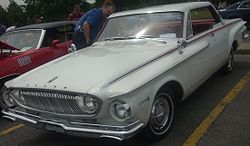
Production 1962 Assembly Newark, Delaware, United States Body style 4-door sedan
4-door hardtop
4-door wagon
2-door sedan
2-door hardtop
2-door convertibleEngine 225 cu in (3.7 L) Slant-6 I6
318 cu in (5.2 L) V8
361 cu in (5.9 L) V8
413 cu in (6.8 L) V8Transmission 3-speed manual
3-speed Torqueflite automaticRelated Plymouth Valiant
Chrysler Valiant
Dodge PhoenixFor 1962, the Dart was downsized as part of Chrysler's hastily planned effort to compete with what company leaders thought would be downsized large cars from Chevrolet, but turned out to be the compact-sized Chevy II Nova, which was introduced as a basic front-engined compact to better compete with the Ford Falcon, Rambler American and Plymouth Valiant than the rear-engined Corvair could. Chevrolet continued to field the Impala as a genuinely full-size car, and the Dart was perceived more as an intermediate - like AMC's Rambler Classic or the newly introduced Ford Fairlane - than as a true full-size car. The Polara shared the body change with the Dart, but was offered in higher trim. Dodge dealers voiced their displeasure at being unable to offer consumers a true "full-size" car. To placate its dealer network, Chrysler hastily created the Dodge Custom 880 by mating its 1961 Dodge Polara front clip to its 1962 Chrysler Newport's de-finned body. Debuting in January 1962, the Custom 880 helped to remind customers that Dodge indeed offered a full-size car.[5]
Styling aside, the new Dart was on an all-new lightweight unibody platform, featuring Chrysler's well-received torsion-bar front suspension and asymmetric leaf springs. The rigidity gained through the nearly pure unibody platform combined with the suspension's low unsprung weight and near-ideal geometry provided sound handling, braking, and acceleration; the latter especially with the mid-year 415 hp (309 kW) "Ramcharger" 413 cu in (6.8 L) V8 which was aimed primarily at sanctioned drag racing, where it quickly broke performance records.
The Seneca, Pioneer and Phoenix trim levels were dropped in 1962. Dart trim levels became Dart 330, Dart 440, and Dodge Polara 500, the latter being offered in 2-door hardtop and convertible styles only with a 4-door hardtop added in December. The Polara 500 was not built or sold in Canada, and the Dart series were the same as in the U.S. except that a lower-specification Dart 220 model was offered to Canadians.[14]
Export markets
Right-hand drive 1960, 1961, and 1962 Darts were exported to commonwealth countries such as Australia, South Africa, Singapore and badged as the Dodge Phoenix. In South Africa, a DeSoto-branded version of the car called the Diplomat was sold from 1960–1962, as well. Once the Dart name was moved to Dodge's compact car for 1963, the Phoenix was no longer Dart-related; each year thereafter through 1971, the Phoenix name was applied to the RHD version of a Dodge or Plymouth B-body or C-body for Commonwealth export.
1963–1966
Third generation 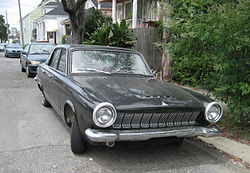
Production 1963–1966 Assembly Belvidere, Illinois, United States
Detroit, Michigan, United States
Hamtramck, Michigan, United States
Los Angeles, California, United States
St. Louis, Missouri, United States
Buenos Aires, ArgentinaBody style 2-door sedan
4-door sedan
4-door wagon
2-door hardtop coupe
2-door convertiblePlatform A-body Engine 170 cu in (2.8 L) Slant-6 I6
225 cu in (3.7 L) Slant-6
273 cu in (4.5 L) V8Transmission 4-speed manual
3-speed manual
3-speed Torqueflite automaticWheelbase 111 in (2,819 mm)[15]
Wagon: 106 in (2,692 mm)Length 196 in (4,978 mm)
Wagon: 190 in (4,826 mm)Width 70.8 in (1,798 mm) Height 55.9 in (1,420 mm) Related Plymouth Valiant
Plymouth Barracuda
Chrysler ValiantFor 1963, Dodge dropped the Lancer nameplate and applied the Dart name to Dodge's newly designed "senior compact", a marketing term referring to the wheelbase having grown to 111 in (2,819 mm) from the Lancer's 106.5 in (2,705 mm). This longer wheelbase would underpin all Darts from 1963-1976 except the 1963–1966 station wagon (106 in (2,692 mm) wheelbase) and the 1971-1976 Demon/Sport (108 in (2,743 mm) wheelbase). The Dart was available as a 2- or 4-door sedan, a 2-door hardtop coupe, a station wagon, and a convertible. Three trim levels were offered: the low-spec 170, the high-spec 270, and the premium GT, which was available only as a 2-door hardtop coupe or convertible. The Dart was an instant market success, with 1963 sales up sharply compared to those of the 1962 Lancer, and the Dart remained extremely popular through the end of the Dart's production run in 1976.[5]
Initial engine offerings were two sizes of the slant-6: a 170 cu in (2.8 L), 101 hp (75 kW) version was fitted as standard equipment, and a 225 cu in (3.7 L), 145 hp (108 kW) version was available for less than $50 extra. The aluminum engine block for the 225 was discontinued early in the 1963 model year. After the start of the 1964 model year, an all-new, compact, lightweight 273 cu in (4.5 L) LA V8 producing 180 bhp (130 kW) with a 2-barrel carburetor was introduced as the top engine option. 1964 was the last year for pushbutton control of the optional Torqueflite automatic transmission, so 1963 and 1964 models were the only compact Darts so equipped.[5]
In 1965, the 2-barrel 273 remained available, but a new "Commando" version of the 273 engine was released with a 4-barrel carburetor, 10.5:1 compression, a more aggressive camshaft with solid tappets, and other upgrades which increased output to 235 bhp (175 kW). At the same time, the Dodge Dart Charger was offered. The Dart Chargers were yellow Dart GT hardtops with black interiors, Commando 273 engine, premium mechanical and trim specifications, and special "Charger" badging. They were the first Dodge models to bear the "Charger" name. The following year the larger B-body Dodge Charger was introduced, and the "Charger" name was thenceforth associated with Dart models only in the "Charger 225" marketing name for the optional larger 6-cylinder engine.
Other new options for 1965 included upgraded suspension components and larger 14 in (356 mm) wheels and tires. Factory-installed air conditioning became available after the start of the 1965 model year, as well as disc brakes, which required the 14 in (356 mm) wheels to clear the calipers.
D-Dart
Dodge offered an ultra high performance version of the Dart GT in 1966. Known as the D-Dart for its intended competitive use in NHRA's D/Stock class, the 273 V8 was tweaked to produce 275 bhp (205 kW). Most of the power came from a larger carburetor and a more radical camshaft. The bulletin sent to the dealers from Chrysler also mentions an 8.75 in (22.2 cm) rear axle with 4.89:1 final drive ratio. This car did not carry Chrysler's 5-year/50,000-mile warranty.[citation needed]
SCCA Competition
Also in 1966, the SCCA introduced the new Trans-Am Series 2-litre to 5-litre class that allowed competition among Dodge Darts, Plymouth Barracudas, Chevrolet Corvairs, Ford Mustangs, and other "Production Touring Cars" with a maximum wheelbase of 116 in (2,946.4 mm). Few modifications were allowed; bumpers, rear seats, and floor mats could be removed, mufflers could be replaced with straight pipes, and different wheels could be used so long as the stock rim diameter and width were maintained.[16] Any engine component available over the dealer parts counter was sanctioned for use.[16] Bob Tullius' race team, called "Group 44," used Dart 270 model coupes and GT coupes with 273-4bbl engines and were sponsored by Quaker State. The team won the 24 hour endurance race at Marlboro Motor Raceway in car No.4 driven by Tullius and Tony Adamowicz, who would also go on to win at Riverside International Raceway.[16] Unfortunately, Dodge pulled sponsorship of the Darts after one season after being dominated by the Alfa Romeo GTA team of Austrian-born Horst Kwech and the Swiss driver Gaston Andrey.
1967–1976
Fourth generation 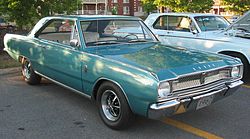
Also called Dodge Demon Production 1967–1976 Assembly Belvidere, Illinois, United States
Detroit, Michigan, United States
Hamtramck, Michigan, United States
Los Angeles, California, United States
St. Louis, Missouri, United States
São Bernardo do Campo, São Paulo, Brazil
Bogotá, ColombiaBody style 4-door sedan
2-door sedan
2-door hardtop
2-door convertible
2-door coupéPlatform A-body Engine 170 cu in (2.8 L) Slant-6
198 cu in (3.2 L) Slant-6
225 cu in (3.7 L) Slant-6
273 cu in (4.5 L) LA V8
318 cu in (5.2 L) LA V8
340 cu in (5.6 L) LA V8
360 cu in (5.9 L) LA V8 383 cu in (6.3 L) RB V8
440 cu in (7.2 L) RB V8Transmission 4-speed manual
3-speed manual
3-speed Torqueflite automaticWheelbase 110 in (2,794 mm)
Demon/Sport: 108 in (2,743 mm)Length 196.2 in (4,983 mm)
Demon/Sport: 192.5 in (4,890 mm)Width 96.6 in (2,454 mm)
Demon/Sport: 71.6 in (1,819 mm)Height 54 in (1,372 mm) Related Plymouth Valiant
Plymouth Barracuda
Chrysler Valiant
Dodge Polara (Argentina)The Dart and its sister model — the Plymouth Valiant — were substantially redesigned for the 1967 model year. In addition to new styling, the cars received revised steering systems, wider front track and frame rail spacing, and redesigned K-members capable of accepting larger engines. The Dart would keep this basic form, with facelifts consisting of revised front and rear end styling and interior trim, until the end of A-body production in 1976 (North America) 1981 (South America). Towards the end of U.S. production, the Dart and Valiant lines were merged from two distinct models with different dimensions up to 1973, to substantially identical badge-engineered twins starting in 1974.
The restyled Dart for 1967 featured a rear window with compound inverse curves. This created a unique appearance at the rear of the greenhouse, but tended to collect snow and created thick C-pillars that looked formal but created blindspots for drivers. Curved side glass was used for the first time on a Chrysler compact. Up front, there was a new dual-plane front end contour: the center section of the grille, bumper and leading edge of the hood were recessed from the front plane of the car. The single headlamps were placed forward of the recessed center section, defining the front plane. Park/turn lamps were set into the grille, in the corners formed by the transition area between the recessed and forward sections. This same front end treatment, with minor cosmetic changes to the grille and the park/turn lamps relocated to the front bumper, was also used by Chrysler Australia for their 1967 VE-model Valiant.[17]
With the new design, changes were made to the Dart lineup, beginning with the elimination of its station wagons and the base model's "170" designation. The only body styles were the 2- and 4-door sedans, the hardtop, and the convertible. The base 170 model was now badged simply as Dart. The 270 and GT versions carried on unchanged for the most part. In late 1967, the GTS model debuted but was built in limited quantities due to its lateness in the model year; the 1968 GTS would be, arguably, improved by fitting the new high-output 340 cu in (5.6 L) V8 as standard equipment.[5]
The 2-door sedan was dropped at the end of 1968 and replaced with the Swinger 2-door hardtop for 1969. Also added was the Swinger 340.
Engines
The 170 cu in (2.8 L) Slant-6 engine remained standard equipment, though its power rating rose from 101 bhp (75 kW) to 115 bhp (86 kW) for 1967, owing to the installation of the 225 engine's larger carburetor and the revised camshaft the bigger engine had received in 1965. For North American domestic-market vehicles, the base 170 engine was replaced for 1970 with a stronger new 198 cu in (3.2 L) version of the slant-6. This new base engine was also less costly to make, for unlike the previous 170 engine, the 198 used the same block as the 225. The smaller displacement was achieved with a new crankshaft (3.64 in (92 mm) stroke vs. the 4.125 in (104.8 mm) stroke of the 225 crank) and connecting rods (7.006 in (178.0 mm) long vs. the 6.67 in (169 mm) rods in the 225).[18] Nevertheless, the 225 remained an upgrade option. The 2-barrel 273 cu in (4.5 L) small-block V8 was replaced on the option list in 1968 by a 318 cu in (5.2 L) 2-barrel engine. The 318 was rated at 230 bhp (170 kW) versus the 2-barrel carbureted 273's 180 bhp (130 kW). At the same time the 4-barrel carbureted 273 235 bhp (175 kW) was replaced on the options list by the 275 bhp (205 kW) 4-barrel carbureted 340 cu in (5.6 L) available only in the 1968-1972 Swinger and the hottest Dart, the performance-oriented GTS models. The Dart GTS came standard with the 340 cu in (5.6 L) V8. A 300 hp (220 kW) 383 cu in (6.3 L) big-block was optional. In 1968, fifty 440 CID 350 bhp versions were available for special order to satisfy NHRA sanction rules. They were special models removed from the regular assembly line as an unfinished, and sent to The Hurst Corp For fitment of the 440 Cid Engine. This was to satisfy NHRA Sanction Rules. In 1969, the 440 CID 350 bhp engine was upgraded to 375 bhp, and became available to the public as a regular production line option. This is according to Chrysler Corporations "MOPAR Direct Connection A Body Performance Manual", 1909 versions in 1969 were produced with this option.
Body Chassis
Changes for 1968 were more subtle. The park/turn lights in the grille were moved slightly inboard and made round. Sidemarker lights were added to the front fenders and rear quarter panels, to comply with newly introduced Federal Motor Vehicle Safety Standard 108. Other changes to comply with new federal safety laws included collapsible steering columns, additional padding on the dashboard and sunvisors, a brake system fault warning light, shoulder harnesses (separate, this year and until 1973, from the lap belts) and non-glare matte finish on the windshield wiper arms. Chrysler's "Clean Air Package" emission control system became standard equipment on cars sold in all 50 states.[19] The steering linkage was revised again, as were the windshield and rear window gaskets and trim-lock strips, leaving the 1967 pieces as one-year-only items. The standard rear axle ratio was dropped from 2.93 to 2.76 with all standard-performance engines and automatic transmission. Part-throttle downshift functionality was added as a refinement to the TorqueFlite automatic transmission in 6-cylinder cars, to retain acceptable city performance with the taller rear axle ratio.[19]
For 1969, the Dart received trim updates including another minor revision of the grille, and a return to rectangular park/turn lights. The 1968 round sidemarker lights were replaced with rectangular reflectors. Head restraints were optional equipment until January 1, 1969, when their installation became mandatory under federal law. The 6-cylinder models received a carburetor anti-ice system borrowed from Canadian-market Chrysler 6-cylinder engines,[20] and the drum brake automatic adjusters were revised for more consistent operation.[21] Also, the 2-door pillared sedan was deleted from the lineup. At the top of the Dart performance range for 1969, there was limited availability of the 440 V8 in the Dart GTS model and a very few 426 Hemi models in the "Hurst" edition Dart.
SCCA & Super Stock competition
In 1967, the Dart entered the Sports Car Club of America's (SCCA) new Sedan Class racing series. For racing in this series, the compact cars, which included Ford Falcons and Plymouth Barracudas as well as foreign makes, were prepared like stock cars on the NASCAR Grand National circuit. "Baby Grands" was the nickname coined for these cars. Darts were powered by the 4-barrel 273 V-8 and were equipped with roll cages and 15 in (381 mm) wheels with fat tires. Bob Tullius, widely known for his Quaker State Group 44-marked cars, was one of the first to drive the Dodge Dart in the sedan class, and with notable success.[22]
Although racers like Dick Landy and Don Garlits had modified Darts in the mid-60s to run in the NHRA Funny Car class using the 426 Hemi, Super Stock class racing of the Dart was almost non-existent due to the small V-8s available. In 1968, Dodge contracted Hurst Performance to build a limited number of 440 in³ V8-wedge and 426 Hemi-powered Darts to compete in the SS/B class as the LO23 Hurst Hemi Dart. Dart body shells were shipped to Hurst who would install a magnesium cross ram-inducted 426 Hemi into the engine bay, facilitated by sledge hammer hits to the fender wells to make room for the Hemi's installation.[citation needed] The rear wheel well arches were also modified in the same manner the shock towers were modified up front.[citation needed] Features included a fiberglass nose, fenders and hood, lightened bumpers, no side view mirrors, radio and heater delete, no soundproofing in the floor and firewall, no back seat, a trunk-mounted battery, acid dipped doors, belt straps for window cranks, Lexan windows, and Dodge A100 van seats mounted on drilled seat rails for decreased weight.[citation needed] These Darts rode on 7 x 14" steel wheels and came in two shades of gray primer with the nose a darker shade than the rest of the body.[citation needed] When shipped to a dealership, a Hemi Dart had a disclaimer on the window stating "Warning: this Super Stock vehicle is to be shipped on the bottom level only of all rail and truck transportation"; this was to ensure that the Hemi's low-hanging oil pan would not get damaged and keep the fiberglass nose from being damaged on any low-hanging obstacles.[citation needed] The Plymouth version was the Hurst Hemi Barracuda.
These cars would successfully cover the quarter mile with elapsed times in the ten second range.[citation needed] According to Chrysler staff engineer Larry Shepard, the majority of these Darts were Hemi powered, all though a small pilot run of fifty 440-powered Darts were also built in 1968.[23] "In 1969," said Shepard, "we built over 600 440-powered Darts-basically the same as the 383 GTS, except for the engine."[23]
1970
The Dart was refreshed for 1970 with front and rear changes designed to bring the car closer to the design themes found in Dodge’s full-size vehicles through grille and contour changes. In the rear, the Dart’s new rectangular tail lights were set into a wedge-shaped rear bumper design continuing the angled trailing edge of the new deck lid and quarter panels. The revised rear styling cut trunk space almost in half compared to the 1969 model. 14-inch wheels became standard equipment, and the 170 cu in (2.8 L) Slant-6 was replaced by a larger 198 cu in (3.2 L) version for improved base-model performance and greater manufacturing economy (since the 198 shared a block with the 225, while the 170 had used its own block). Changes to the fuel system improved drivability, economy and emission control. Part-throttle downshift was added to the 8-cylinder automatic transmissions. In compliance with FMVSS 108, sidemarker lights and reflectors were installed at all four corners. All 1970 Darts were built in the Windsor, Ontario (Canada) assembly plant, regardless of engine / model / designated country .
The Swinger name was applied to all the Dart two-door hardtops except in the high-line Custom series. A number of other changes were made to the Dart line to avoid internal competition with Dodge's new Challenger: the Dart convertible was discontinued along with the optional 383 cu in (6.3 L) V8, leaving the 275 bhp (205 kW) 340 4-barrel V8 as the top Dart engine.[5] The sole performance model in the Dart line for 1970 was the Swinger 340 2-door hardtop. The 1970 Swinger 340 came with non-functional hood scoops with 340 decals. These scoops were the same as used on the Super Bee when the Ramcharger fresh air intake hood was ordered, but the Ramcharger was not available on the Swinger 340. Front disc brakes were standard. Other standard items were Rallye suspension, a 3.23:1 rear axle ratio, fiberglass-belted bias-ply tires mounted to steel wheels, and a bumble bee stripe. The list of options for the Swinger 340 was extensive: all-vinyl bucket seats could replace the standard bench seat, and this permitted one to order a center console. A performance hood upgrade with scoops was painted flat black with hood tie-down pins. Available options included power brakes, steering, and windows. Rallye wheels and wire wheelcovers were also optional, as was a 6000 rpm tachometer and a vinyl roof in either black or white. For whatever reason, an AM/FM radio wasn't offered (it was an option for the '67, '68 and '69 models); and it wouldn't return as an option again until the 1972 model year.
1971
The 1970 Dart's dual taillamps were given over to the badge-engineered Plymouth Valiant Scamp, while the 1971 Dart received new smaller quad taillamps that would be used through 1973. The Custom 2-door hardtop sedan became the Swinger, and the standard Swinger became the Swinger Special. Dodge gained a version of Plymouth's popular Valiant-based fastback Duster and was to be named the Beaver,[24] but when Chrysler's marketing department learned that 'beaver' was C.B. slang for vagina,[25] the vehicle was renamed the Dart Demon.
As was the case with previous Dodge rebadges of Plymouth Valiants, such as the 1961–1962 Lancer, sales of the Demon lagged behind those of the Duster. With optional hood scoops and blackout hood treatment, the car was advertised a high-performance car. The Demon's Dart-type front fender wheel lips and Duster-type rear wheel fender lips reveal the car was essentially a Duster with Dart front sheetmetal and other minor styling changes. A new audio option became available for 1971: Chrysler's Cassette-Recorder. Unlike the 8-Track tapes, the cassette player was relatively compact, and it was mounted on the console or on its own floor-mount casing. This unit offered an available microphone in which one could record their own dictation.
The Swinger 340, Dart's performance model, was replaced by the Demon 340 with optional hood scoops and blackout hood treatment. Chrysler Canada, though, did build a small number of 1971 Swinger 340 hardtops based on the Swinger Special for two dealers in Western Canada.[citation needed] In 1971, Chrysler abandoned their longstanding corporate practice of installing left-hand threaded wheel studs on the left side of the vehicle; all wheel studs on the Dart thenceforth used conventional right-hand threads.[26]
1972
Changes for 1972 included a revised grille without the central divider of the 1970 and 1971 items, new surface-mounted sidemarker lights rather than the previous flush-mount units, a new instrument cluster featuring a large rectangular speedometer and several small round gauges; the AM/FM radio option returned. The Demon had new fender-mounted metal "Demon" badges without the small devil character on the 1971 decals. The "Demon" decal on the rear of the car was replaced by DODGE and DART emblems on the lower right edge of the deck lid. Some Demons with the side and rear panel tape stripes retained the tape devil character.[27][28] A new optional single hood scoop replaced 1971's dual scoops, and was coupled with a hood paint blackout that had been standard on the 1971 high-trim/high-value Demon Sizzler model. Cars equipped with the optional ralley wheels now came with newly restyled center caps finished in a light argent (silver) paint.
1973
1973 Darts got new front styling with revised fenders, grille, header panel, and hood. Massive front bumpers were installed to comply with new federal regulations, as well as side-impact guard beams in the doors and new emission control devices. New single-piston disc brakes replaced the more complex 4-piston units offered from 1965–1972, though Chrysler did not address the premature rear-wheel lockup that continued to plague disc brake equipped Darts.[citation needed]
Chrysler's new electronic ignition system was standard equipment on all engines, and starter motors were revised for faster engine cranking. The K-frame was modified to accommodate a new spool-type engine mount that limited engine roll to 3°. The upper ball joints were upgraded to the larger B-body units. Along with these chassis changes, the wheel bolt pattern on Darts with disc brakes was enlarged from 4 in (100 mm) to the 4.5 in (110 mm) pattern common to the larger B- and C-body Chrysler-built passenger cars. Darts with 4-wheel drum brakes continued with the 4 in (100 mm) bolt pattern.[29] Gone for the 1973 model year (and only on the "A" Body line, Dart, Duster, et al.) was the tried and true, bulletproof eight & three-quarter differential. In its stead was the eight and one-quarter, 10-bolt service cover, differential. Top gear ratio was still 3.55, with the Sure Grip being an option (but was mostly standard when 3.21's and 3.55's were ordered). Vent windows disappeared from all 2-door hardtops; however, the sedans retained them through the end of production (1976).
The Demon fastback was renamed Dart Sport in response to Christian groups' complaints about the 'Demon' name and devil-with-pitchfork logo.[5] The high-performance models thus became Dart Sport 340 in 1973, and Dart Sport 360 for 1974 when the 360 cu in (5.9 L) V8 replaced the 340 cu in (5.6 L) V8. 1973 saw styling changes to go along with the name change on the Duster-bodied car. The Dart Sport received the same new front end as the other Darts, and its taillights were changed to two lights per side, each with a chrome trim ring. These would remain unchanged through the 1976 model year.
1974
In 1974, the US federal 5 mph (8.0 km/h) bumper impact standards were expanded to cover rear bumpers as well as front ones, and as a result the Swinger and Dart sedan's rear bumpers grew much more massive. Taillights larger than the previous year's items were set above the rear bumper, rather than within it. Shoulder and lap belts were finally combined in all Chrysler products into a retractable, inertia-sensitive, single-buckle design Chrysler called "Unibelt", replacing the difficult-to-use separate lap and shoulder belts that had been installed through 1973.
The Dart and its Plymouth Valiant sibling led the American compact car market during the early 1970s.[citation needed] Their already-strong popularity was bolstered by the Arab oil embargo of 1973, which caused gasoline shortages with long lines at stations and dramatic price increases at the pump. To capitalize on an emerging trend toward luxurious compact cars, Dodge introduced the Dart SE (Special Edition) in mid-1974 as a four-door sedan and two-door hardtop. The SE included velour high back bucket seats with folding armrest, carpeted door panels, woodgrain instrument panel and deluxe wheel covers along with a TorqueFlite automatic transmission as standard equipment. The air conditioning system available on all Darts had increased capacity, quicker cooldown and lower minimum temperatures.[30] An evaporator pressure regulator valve, long used on larger Chrysler products, varied the compressor's capacity without cycling the clutch.
1975
Aside from a new grille, the 1975 models were virtually identical to the 1974s, except that California and certain high-altitude models were equipped with catalytic converters and so required unleaded gasoline. All 1975 models were required to pass a roof crush test and to meet this stringent requirement, and additional reinforcements were added to all Dart 2-door hardtops.[30] Heavy gauge steel in the windshield pillar area had been incorporated into the windshield, pillar and roof design. Darts were also equipped with an improved energy absorbing steering column which used multiple slots in the column jacket to replace prior used convoluted mesh design. At impact, force applied to the steering wheel curled the column jacket back over a mandrel mounted on the floor. Federal Motor Safety Standards briefly required that the front seat belts include a starter interlock system that prevented the engine from starting unless the front seat outboard occupant and the driver fastened their belts.[30]
A 4-speed manual transmission was offered with the 6-cylinder engine for the first time in the North American market since 1965, and with a new 30% overdrive 4th gear ratio.[31] It was Chrysler's first application of an overdrive system since 1959.[32] The final drive ratio in fourth gear was 2.36:1 on the Slant Six cars equipped with 3.23:1 rear axle, and 2.15:1 on the V8s equipped with 2.94:1 rear axle. The result was less engine noise and wear and greater fuel economy.[32]
Also for 1975, heaters had 14% more heating capacity than in the previous year's models.[30] The added capacity was the result of adding a third speed to the blower system, which provided 20% greater air flow at maximum setting.[30] The electrically heated backglass defogger grid timer cycle was doubled to 10 minutes.[30]
1976
1976 was the Dart's final year in the North American market. The rear-view mirror was mounted on the windshield rather than from the ceiling. Front disc brakes became standard equipment on 1 January 1976 in accord with more stringent U.S. Federal brake performance requirements, and a new foot-operated parking brake replaced the under-dash T-handle used since the Dart's 1963 introduction as a compact car. The grille's parking lamps were cast in amber, whereas the previous years had clear lenses with amber-colored bulbs.
Over its 13-year production run, the Dart earned a reputation as a sturdy, dependable car. "The Dart was one of the most successful compact cars ever introduced in the American automobile marketplace," according to R.D. McLaughlin, then vice president of Chrysler's Automotive sales division, "It enjoys a strong owner loyalty and is a car that has established a reputation for reliability and value…these are [some] reasons why we will continue to market the Dart while introducing the new compact Aspen."[33] Ultimately, the A-body Dart was replaced by the F-body Dodge Aspen beginning in late spring of 1976—a replacement Chrysler President Lee Iacocca would later lament due to the Aspen's many early quality problems.
Dart Sport
The Dart Sport 360 was dropped as a separate model in 1976, but the 360 cu in (5.9 L) four-barrel, dual exhaust (without catalytic converters) V8 was a $376 option (except in California) for the $3,370 Dart Sport V8 models with automatic transmission.[34] Car & Driver magazine tested the Dart Sport 360 in the April 1976 issue, pitting it against the Corvette and Trans Am Firebird, and found its top speed of 121.6 mph (195.7 km/h) to be second to the Corvette's 124.5 mph (200.4 km/h).[35]
A38 Police Package
In 1976, the Dart was offered with a police package, with production code A38. The A38 Dart had the highest-specification components and systems throughout, including a heavy-duty suspension with a rear sway bar,stronger leaf springs and firmer shock absorbers, larger brakes with semi-metallic front disc pads, maximum engine cooling, and high-capacity alternator and battery. The engines were Chrysler's 225 Slant Six, 318 V8, and 360 cu in (5.9 L) LA V8 (220 H.P., with non-catalyst in 49-state models and a true dual exhaust; California models had a single exhaust with the catalytic converter) with an A727 TorqueFlite transmission. Police-specific equipment such as a calibrated speedometer ("Certified" 120 mph), high-intensity dome light, and wiring harness for a rooftop light bar were standard equipment, and an A-pillar spotlight and push bars were optional. Production volume was low, with most A38 Darts going to the Los Angeles and Ventura Police Departments in Southern California. For the most part, police agencies preferred the larger intermediate Dodge Coronet or full-size Dodge Monaco.
Taxi package
Darts were offered to the taxicab industry for their whole production run from 1963-1976. While specifications varied by year, interior upgrades generally included heavy-duty front and rear black rubber floor mats, heavy-duty seat cushion springs with full foam back and air-foam seats, black all-vinyl trim with heavy canvas-backed vinyl seat covers, interior door pull assist straps or handles, and a door-ajar warning light for the driver. Mechanically, Dart taxicabs were generally equipped with heavy-duty brakes, tires, shock absorbers, front torsion bars and rear leaf springs, a high-output alternator, an increased-capacity cooling system and extra-lean carburetor calibration for greater economy. In 1976, the Chrome Yellow taxi package was available only with a 225 Slant Six engine producing 95 hp (71 kW) and 170 lb·ft (230 N·m); transmission was the (rare) A-727-RG ("RG" = Raised-deck "G" motor, which was the Slant Six series) with California emissions, 90 hp (67 kW) and 165 lb·ft (224 N·m). Options included a radio suppression package and a Fuel Pacer System. Many—if not all—of them had a body colour paint sales code of "999", meaning Special Order Paint[36]
Dart Sport packages
Convertriple & Hang Ten
For 1974, the "Convertriple" option on the Dart Sport included a fold-down rear seat/security panel offering 6 ft 5 in (1.96 m) of lengthwise space, and a manually operated metal sunroof.[37] It was advertised as "Three Cars In One": an economy compact, a convertible alternative with a sunroof, and a roomy station wagon alternative thanks to the fold down rear seat. The fastback roofline and fold down rear seat were similar in concept to the 1964-69 Plymouth Barracuda and the 1966-67 Dodge Charger.
The Convertriple was the basis for the "Hang Ten", a car directed toward surfers in an attempt by Dodge stylists to better determine consumer preferences in a declining performance market.[38] The Eggshell White car took its name from the surfing expression for balancing at the end of a surfboard with ten toes over the nose of the board while riding the wave. The fold-down rear seat permitted the loading of a surfboard through the trunk. With no need to transport the surfboard on top, this permitted the factory-installed sunroof. These two features were already available on the Dart Sport, but the Hang Ten went further with the surfing theme. Swimsuit material in various colored stripes was set into the seats and door panels. Bright orange shag carpet covered the back of the fold-down rear seat. The orange was picked up on the dash and on the center console. The swimsuit material pattern was repeated as red and blue exterior stripes started at the quarter panels with a wave-riding surfer graphic. A surfboard design ran down the center of the hood. Between the taillights, the stripe pattern fattened into surfboard-shaped letters that spelled out "Hang Ten".
Caravan Tan
In mid-1974, Dodge introduced the "Caravan Tan" trim package. Features for this Dart Sport included a desert-hued vinyl bench seat with multi-colored stripped inserts and white pipping, and gold-colored instrument panel, dash board and carpeting. Exterior color choices were Dark Moonstone, Sienna, Gold Metallic, Dark Gold Metallic, Golden Fawn and White.
Spirit of '76
In a tie-in with the United States Bicentennial, a "Spirit of '76" edition of the Dart Sport featured white paint with prominent red and blue bodyside striping meant to evoke the image of the American flag.
Dart Lite
In response to increased interest in fuel economy, Dodge offered the "Dart Lite" fuel economy package which weighed at least 150 lb (68 kg) less than the ordinary Dart Sport.[33] The 225 Slant Six was the only available engine, equipped with an aluminum intake manifold for the first time since 1960 and a specially calibrated carburetor and distributor. Bumper reinforcement brackets were aluminum instead of steel, while the hood and trunk lid bracing and inner panels were also aluminum. The Slant Six engine block had already been modified for reduced weight in 1975; in the middle of 1976 production its crankshaft was changed from forged steel to lighter cast iron. The high-flow exhaust system included a dual-biscuit catalytic converter, a 2¼" headpipe, and the muffler used on V8 models. The Dart Lite was equipped with a 2.94:1 rear axle rather than the customary 3.21:1 ratio when the car was ordered with a three- or four-speed manual transmission. The A833OD overdrive 4-speed manual transmission housing was made of aluminum. Like all other Darts, the Dart Lites with automatic transmission came with a 2.76:1 rear axle as standard equipment.[33] The Dart Lite with manual transmission was rated by the EPA at 36 mpg (6.5 l/100km) in highway driving. The Plymouth version was the Feather Duster.
Beyond 1976
Production of A-body Darts continued in Brazil through 1980[39] and Colombia through 1977.[40] Dart-based A-body cars with various names including Coronado, GTX, and Polara were produced in Argentina through 1979.[41] The Dart name (rather than Aspen) was applied to Dodge-branded F-body cars in Mexico, corresponding to the Mexican Chrysler-branded F-body cars badged as Valiant Volare (without the "é" in the "Volare" nameplate). The F-body was withdrawn from production worldwide after 1980, but in Mexico the M-body was badged as a Dodge Dart for 1981 and 1982, the K-body was sold as a Dodge Dart K (and as a Valiant Volare K) from 1982–1989, and the E-body was sold as the Dodge Dart Europa, officially badged as the Dodge Dart E, from 1986–1989. It was a downscale (lower price, cheaper trim) version of the American Dodge 600 4-door sedan. It replaced the Dart K 4-door sedan. Dart K 2-door and wagon models were sold alongside the Dart E until 1988 and the old SOHC I-4 2.2 L engine was replaced by the new 2.5 L I-4 for the 1987 season.[42] These were the last new cars in the world to bear the Dodge Dart name, which was dropped when Chrysler de México introduced the Spirit in 1990.[43]
In Spain
From 1965 to 1977 a Spanish version of the Dodge Dart was manufactured in the Barreiros Villaverde factory in Madrid. A total of 17589 units were manufactured in Spain. The Dart was produced as a SKD due to the protectionist Spanish regulations of those years.[44][45]
The Dart was the biggest national production car available in Spain during all production years. It was an expensive luxury car with very low fuel economy by Spanish standards.
The Dodge Dart GL was a luxury model,[46] while the GT was the sporty version.[47] A later version was the Dodge 3700 GT.[48]
All gasoline Darts had the biggest engine ever mounted into a mass production car in Spain, the 225 in³ Chrysler Slant 6 engine. The "3700" number is a reference to the 3.7 litres of displacement. No other six cylinder engine car has been produced in as big numbers in Spain. Only the 1965-1970 Dart's were based on the original one from America, the Dart 3700 was an own model.
A diesel Dart (named "Barreiros Diesel") was also produced.[49] These models were very basic and very slow, and used the round taillights from the first generation Simca 1000.[50]
There was also a station wagon version, as well as variants (diplomatic motorcade cars, ambulances, hearses, etc.)[51]
Production of Spanish Darts stopped in 1977. Peugeot bought the Villaverde factory, as Chrysler was divesting European operations in Spain, France and the United Kingdom.
Darts were popular with members of the Spanish government during the 1960s and 1970s. Admiral Luis Carrero Blanco was killed on 20 December 1973 while travelling in his Dodge Dart 3700GT.[52] On 12th June 1975, Fernando Herrero Tejedor, the politician mentoring Adolfo Suárez, died in a car accident while travelling in his official Dodge Dart.
Special models
- Dart Charger (1965)
- D-Dart (1966)
- Dart Swinger 340, GTS 440 and Hurst Hemi (1968)
- Dart Sport Hang Ten (1975)
- Dart A38 Police Special (1976)
- Dart Sport Spirit of '76 (1976)
- Dart Lite (1976)
See also
References
- ^ "1956 Chrysler Dart". Carstyling.ru. 2007-07-02. http://www.carstyling.ru/cars.1956_Chrysler_Dart.html. Retrieved 2010-09-29.
- ^ "1957 Chrysler Diablo". Classiccars.about.com. 2008-05-22. http://classiccars.about.com/b/2008/05/22/the-1957-chrysler-diablo-is-going-on-the-block.htm. Retrieved 2010-09-29.
- ^ Witzenburg, Gary. "The Name Game", Motor Trend, 4/84, p.86.
- ^ Witzenburg, p.86.
- ^ a b c d e f g h i j k l McPherson, Thomas A. (1992). The Dodge Story. Crestline Series. Motorbooks International. ISBN 978-0-87938-697-9.
- ^ "Directory Index: Dodge/1960_Dodge/1960_Dodge_Dart_Brochure". Oldcarbrochures.com. http://www.oldcarbrochures.com/static/NA/Dodge/1960_Dodge/1960_Dodge_Dart_Brochure/1960%20Dodge%20Dart%20Brochure-04.html. Retrieved 2011-11-09.
- ^ "Directory Index: Dodge/1960_Dodge/1960_Dodge_Dart_Brochure". Oldcarbrochures.com. http://www.oldcarbrochures.com/static/NA/Dodge/1960_Dodge/1960_Dodge_Dart_Brochure/1960%20Dodge%20Dart%20Brochure-05.html. Retrieved 2011-11-09.
- ^ "Joseph David Newhouse's Dodge Dart compendium". Foundationpc.com. http://www.foundationpc.com/. Retrieved 2010-09-29.
- ^ "'64 Dodge Dart: Road test of the new MoPar compact" Motor Trend, December 1963, p.30
- ^ Slant-6 News, ASIN B00192J1O4
- ^ Flory, J. "Kelly", Jr. American Cars 1960-1972 (Jefferson, NC: McFarland & Coy, 2004), p.100 photo.
- ^ 1961 Chrysler Corporation Passenger Car Parts Catalogue, PLC 8-55
- ^ a b Flory, pp.37 & 102.
- ^ 1962 Dodge "New Lean Breed" Canadian brochure
- ^ "Directory Index: Dodge/1963_Dodge/1963_Dodge_Dart_Brochure". Oldcarbrochures.com. http://www.oldcarbrochures.com/static/NA/Dodge/1963_Dodge/1963_Dodge_Dart_Brochure/1963%20Dodge%20Dart-11.html. Retrieved 2011-11-09.
- ^ a b c 'http://www.autohobbydigest.com/66ta.html'
- ^ Davis, Tony (1987). The Valiant Book. Marque Publishing Company. ISBN 0 947079 00 9.
- ^ Weertman, W.L.: A History of Chrysler Corporation's Slant-Six Engine, 2nd. edition, 2006
- ^ a b Engineering Features for 1968, Chrysler Corporation, September 1967
- ^ Petersen (1975). The Petersen automotive troubleshooting & repair manual. Grosset & Dunlap. ISBN 978-0-448-11946-5.
- ^ Engineering Highlights for 1969, Chrysler Corporation, September 1968
- ^ Young, Tony (1984). Mighty Mopars 1960–1974. Motorbooks International. p. 50. ISBN 978-0-87938-124-0.
- ^ a b Mighty Mopars: 1960-1974' by Anthony Young p. 51-2 ISBN 978-0-87938-124-0
- ^ Young, p.150
- ^ Witzenburg, p.86.
- ^ Chrysler Corporation: Engineering Highlights for 1971. September 1970
- ^ Statham, Steve (2000). Dodge Dart and Plymouth Duster. Motorbooks. p. 72. ISBN 978-0-7603-0760-1.
- ^ Year One 1966-74 Dodge/Plymouth A/C catalog 2007 p. 170
- ^ Chrysler Corporation: Engineering Highlights for 1973, August 1972
- ^ a b c d e f Chrysler Corporation: 'Dart adds to the reputation in era of the compact car'
- ^ Chrysler Corporation: 1976 Passenger Car Engineering Features, August 1975
- ^ a b Chrysler Corporation:'Overdrive-4, Manual Transmission Improves Compact Car Economy'
- ^ a b c Chrysler Corporation: 'New Dart Lite competes for compact economy crown. For release: Friday, October 3, 1975'
- ^ Statham, Steve (2000). Dodge Dart and Plymouth Duster. MotorBooks/MBI Publishing. p. 124. ISBN 978-0-7603-0760-1. http://books.google.com/books?id=Jz-ItcylfasC&pg=PA124&dq=1976+360+Dart+Sport&ei=NHlLS8v7GY7qygTWvpH5DQ&client=safari&cd=1#v=onepage&q=1976%20360%20Dart%20Sport&f=false. Retrieved 2009-01-11.
- ^ Mueller, Mike (2000). Corvette, 1968-1982. MotorBooks/MBI Publishing. p. 105. ISBN 978-0-7603-0418-1. http://books.google.com/books?id=BrPjl25HbucC&pg=PA105&dq=1976+360+Dart+Sport&ei=qnlLS96JOJjCM_7j5IQO&client=safari&cd=6#v=onepage&q=1976%20360%20Dart%20Sport&f=false. Retrieved 2009-01-11.
- ^ Chrysler Corporation: 1976 Dodge Taxi Sales Brochure
- ^ Statham, Steve (2000). Dodge Dart and Plymouth Duster. MotorBooks/MBI Publishing Company. p. 104. ISBN 978-0-7603-0760-1. http://books.google.com/books?id=Jz-ItcylfasC&pg=PA81&dq=Dodge+Convertriple&ei=m-oGS621OpKAywTv8tXADw&client=safari#v=onepage&q=&f=false.
- ^ Young, p. 156
- ^ "A-bodies in Brazil". Valiant.org. http://www.valiant.org/brazil.html. Retrieved 2010-09-29.
- ^ "Dodge Darts in Colombia". Foundationpc.com. 1999-06-22. http://www.foundationpc.com/colombia.html. Retrieved 2010-09-29.
- ^ Denardo, Javier. "Argentinian Mopars at Allpar". Allpar.com. http://www.allpar.com/world/argentina.html. Retrieved 2010-09-29.
- ^ Chrysler de México Brochures (1981-89)
- ^ Chrysler de Mexico: brochures (1982-88)
- ^ "Piel De Toro". Piel De Toro. http://www.pieldetoro.net/z/pieldetoro/colaboraciones/colaboracionesdetal.asp?ID=10. Retrieved 2010-09-29.
- ^ "Grandes Dodge españoles". Grandesdodge.iespana.es. http://grandesdodge.iespana.es/articulododgedart.htm. Retrieved 2010-09-29.[dead link]
- ^ "Dodge Dart GL". Foro.pieldetoro.net. http://www.foro.pieldetoro.net/web/pruebas/ver.php?ID=15. Retrieved 2010-09-29.
- ^ "Dodge Dart GT". Foro.pieldetoro.net. http://www.foro.pieldetoro.net/web/pruebas/ver.php?ID=16. Retrieved 2010-09-29.
- ^ "Dodge 3700GT". Foro.pieldetoro.net. http://www.foro.pieldetoro.net/web/pruebas/ver.php?ID=14. Retrieved 2010-09-29.
- ^ "Diesel Dart". Foro.pieldetoro.net. http://www.foro.pieldetoro.net/web/pruebas/ver.php?ID=17. Retrieved 2010-09-29.
- ^ "Dart Diesel specifications". Grandesdodge.iespana.es. http://grandesdodge.iespana.es/articulododgedart.htm. Retrieved 2010-09-29.[dead link]
- ^ "Spanish Dodge Darts". Foundationpc.com. http://www.foundationpc.com/spanish.html. Retrieved 2010-09-29.
- ^ "The Dodge Dart a bomb could not kill". Foundationpc.com. http://www.foundationpc.com/stories/bomb.html. Retrieved 2010-09-29.
Further reading
- Gunnell, John, ed (1987). The Standard Catalog of American Cars 1946–1975. Krause Publications. ISBN 9780873410960.
- McPherson, Thomas A. (1975). The Dodge Story. Crestline Publishing. ISBN 9780912612072.
External links
- Dodge Dart at the Internet Movie Cars Database
Dodge road car timeline, United States market, 1950s–1970s — next » Type 1950s 1960s 1970s 0 1 2 3 4 5 6 7 8 9 0 1 2 3 4 5 6 7 8 9 0 1 2 3 4 5 6 7 8 9 Subcompact Omni / 024 Colt Compact Colt Colt Colt Lancer Dart Dart Dart Aspen Mid-size Wayfarer Dart Diplomat Coronet Coronet Monaco Magnum Full-size Coronet Coronet Coronet Dart 880 / Custom 880 Royal Royal Matador 330 Monaco Monaco St. Regis Meadowbrook La Femme 440 Custom Royal Polara Polara Polara Polara Sports Charger Charger Charger Charger Challenger Challenger Super Bee Dodge Current
productionCarsTrucks (Ram)Discontinued Cars024 · 330 · 400 · 600 · 880 · Aries · Aspen · Avenger · Brisa · Challenger · Charger (B-body) · Charger (L-body) · Charger Daytona · Colt · Conquest · Coronet · Custom 880 · Dart · Daytona · Demon · Diplomat · Dynasty · Intrepid · La Femme · Lancer · Matador · Mirada · Monaco · Neon · Omni · Phoenix · Polara · SE · Shadow · Sierra · Spirit · SRT-4 · St. Regis · Stealth · Stratus · Super BeeTrucks50 Series · 100 Series · 500 Series · A100 · B Series · C Series · D Series · Power Wagon · Rampage · Ram 50 · VC series · VF series · WC seriesCorporate Category:Dodge vehicles · Chrysler LLCCategories:- 1960s automobiles
- 1970s automobiles
- Compact cars
- Convertibles
- Coupes
- Dodge vehicles
- Full-size vehicles
- Rear wheel drive vehicles
- Sedans
- Station wagons
- Muscle cars
- Vehicles introduced in 1960
Wikimedia Foundation. 2010.

